Strategic HR and Change Management: New Zealand Post Case Study
VerifiedAdded on 2023/04/21
|16
|3229
|495
Report
AI Summary
This report analyzes the implementation of change management strategies at New Zealand Post, focusing on the GOAL initiative and utilizing the Kurt Lewin model. It examines change management from a social process perspective, considering contingency and cultural factors. The report evaluates the effectiveness of the GOAL program in addressing challenges faced by New Zealand Post, such as increased competition and changing customer needs. It also determines whether the change management approach employs a soft or hard strategy, providing examples from the case study to support the analysis. The report concludes by summarizing the key findings and implications of the change management initiatives undertaken by New Zealand Post. Desklib provides a platform for students to access similar solved assignments and study resources.
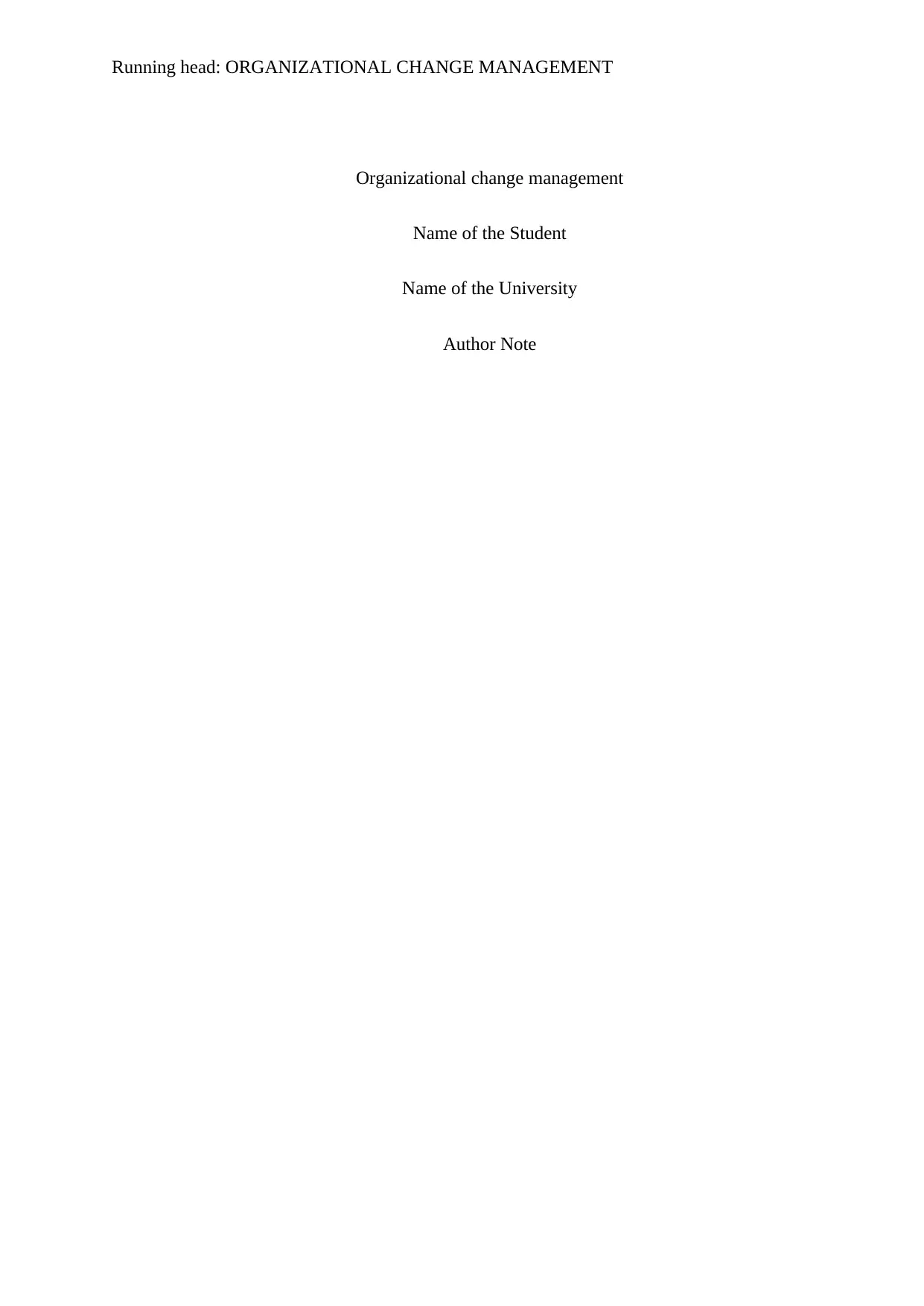
Running head: ORGANIZATIONAL CHANGE MANAGEMENT
Organizational change management
Name of the Student
Name of the University
Author Note
Organizational change management
Name of the Student
Name of the University
Author Note
Paraphrase This Document
Need a fresh take? Get an instant paraphrase of this document with our AI Paraphraser
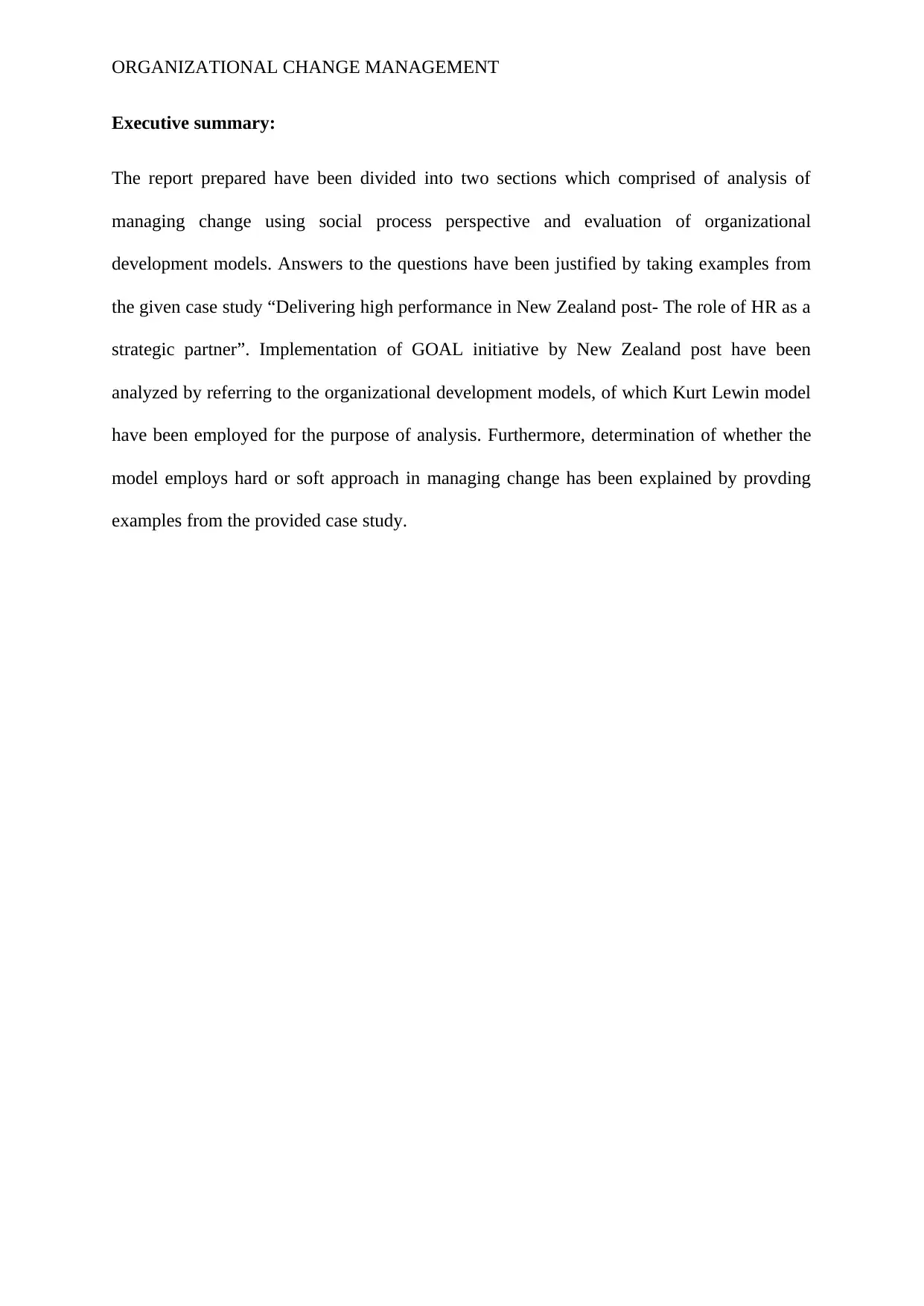
ORGANIZATIONAL CHANGE MANAGEMENT
Executive summary:
The report prepared have been divided into two sections which comprised of analysis of
managing change using social process perspective and evaluation of organizational
development models. Answers to the questions have been justified by taking examples from
the given case study “Delivering high performance in New Zealand post- The role of HR as a
strategic partner”. Implementation of GOAL initiative by New Zealand post have been
analyzed by referring to the organizational development models, of which Kurt Lewin model
have been employed for the purpose of analysis. Furthermore, determination of whether the
model employs hard or soft approach in managing change has been explained by provding
examples from the provided case study.
Executive summary:
The report prepared have been divided into two sections which comprised of analysis of
managing change using social process perspective and evaluation of organizational
development models. Answers to the questions have been justified by taking examples from
the given case study “Delivering high performance in New Zealand post- The role of HR as a
strategic partner”. Implementation of GOAL initiative by New Zealand post have been
analyzed by referring to the organizational development models, of which Kurt Lewin model
have been employed for the purpose of analysis. Furthermore, determination of whether the
model employs hard or soft approach in managing change has been explained by provding
examples from the provided case study.
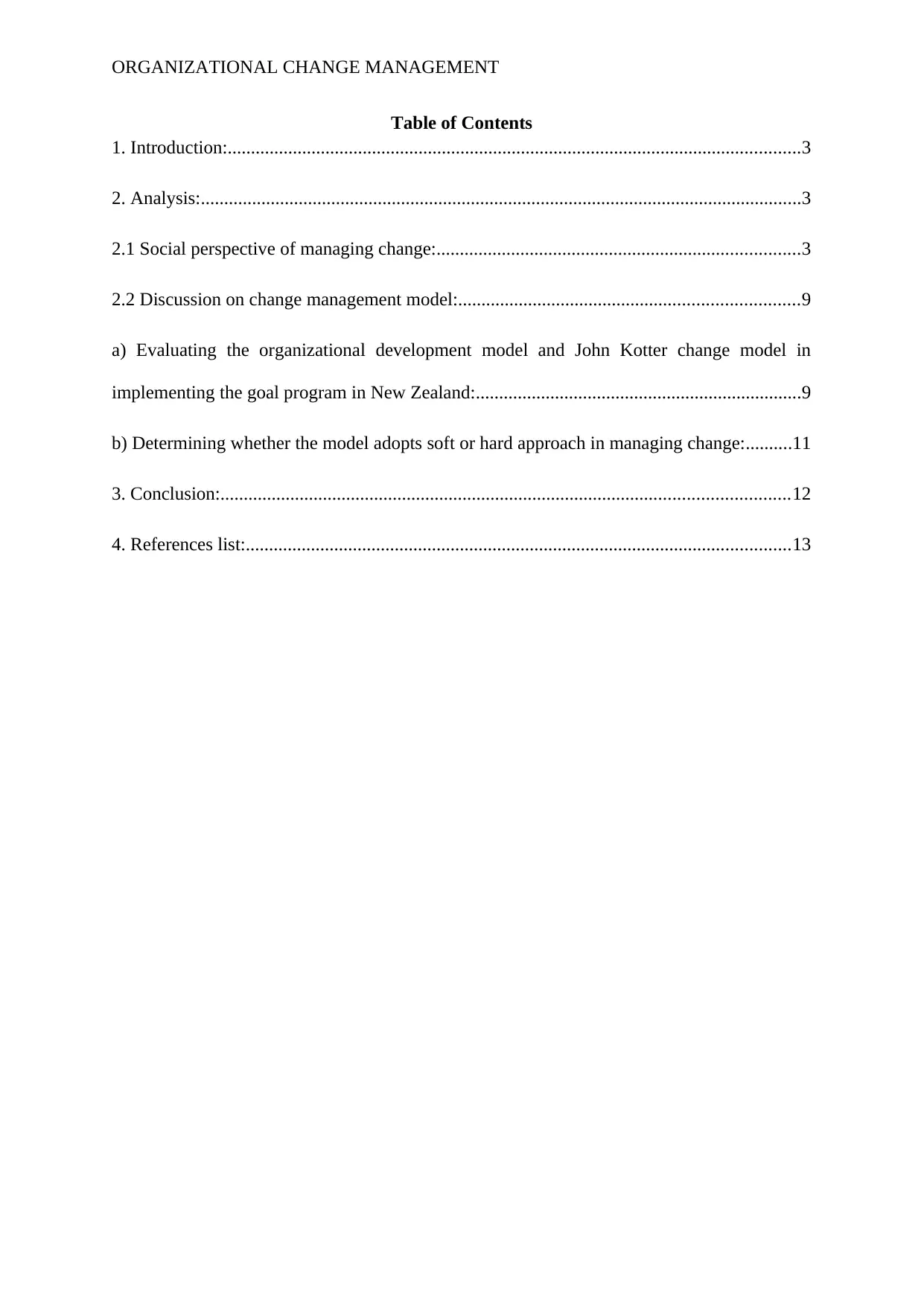
ORGANIZATIONAL CHANGE MANAGEMENT
Table of Contents
1. Introduction:...........................................................................................................................3
2. Analysis:.................................................................................................................................3
2.1 Social perspective of managing change:..............................................................................3
2.2 Discussion on change management model:.........................................................................9
a) Evaluating the organizational development model and John Kotter change model in
implementing the goal program in New Zealand:......................................................................9
b) Determining whether the model adopts soft or hard approach in managing change:..........11
3. Conclusion:..........................................................................................................................12
4. References list:.....................................................................................................................13
Table of Contents
1. Introduction:...........................................................................................................................3
2. Analysis:.................................................................................................................................3
2.1 Social perspective of managing change:..............................................................................3
2.2 Discussion on change management model:.........................................................................9
a) Evaluating the organizational development model and John Kotter change model in
implementing the goal program in New Zealand:......................................................................9
b) Determining whether the model adopts soft or hard approach in managing change:..........11
3. Conclusion:..........................................................................................................................12
4. References list:.....................................................................................................................13
⊘ This is a preview!⊘
Do you want full access?
Subscribe today to unlock all pages.

Trusted by 1+ million students worldwide
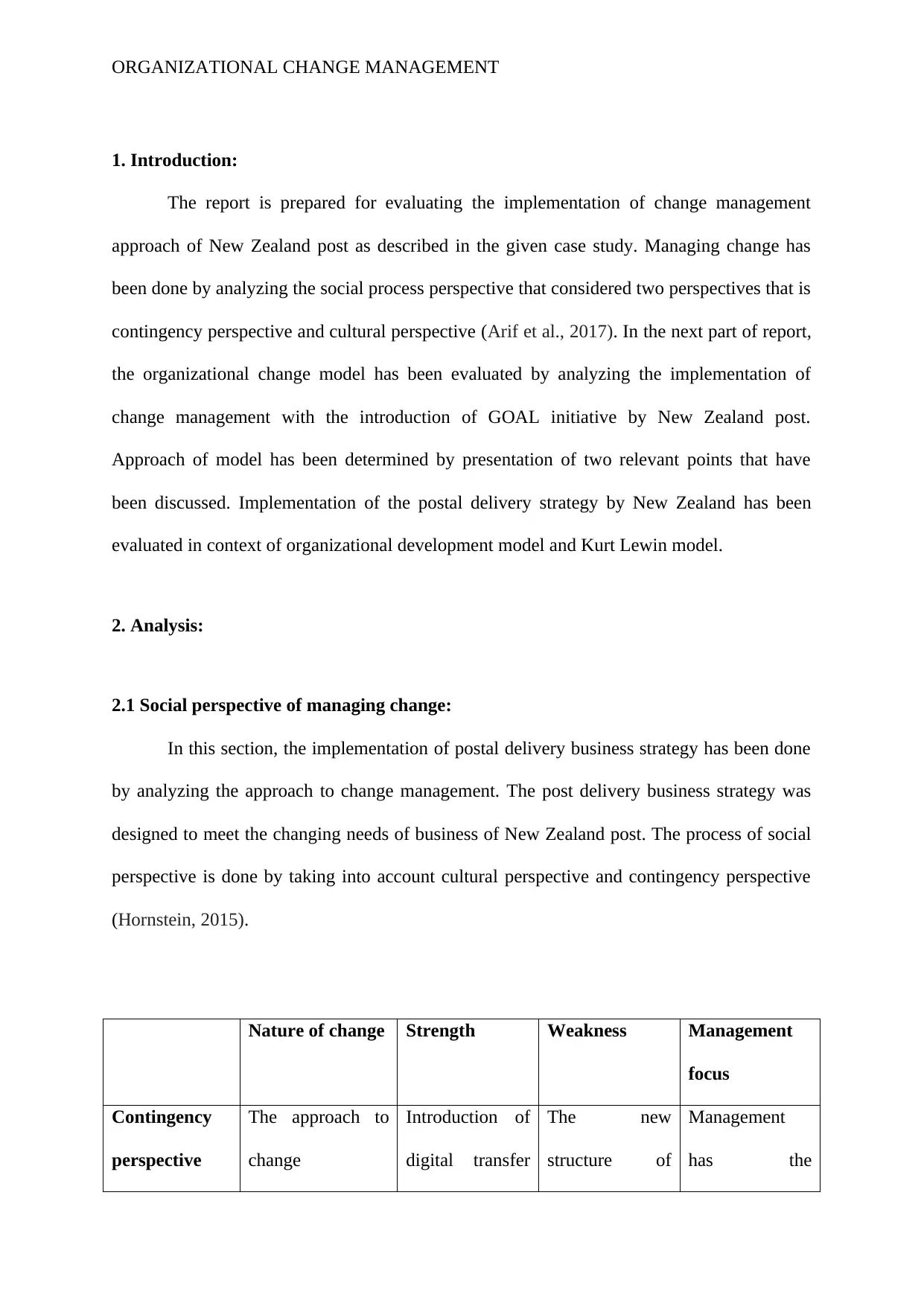
ORGANIZATIONAL CHANGE MANAGEMENT
1. Introduction:
The report is prepared for evaluating the implementation of change management
approach of New Zealand post as described in the given case study. Managing change has
been done by analyzing the social process perspective that considered two perspectives that is
contingency perspective and cultural perspective (Arif et al., 2017). In the next part of report,
the organizational change model has been evaluated by analyzing the implementation of
change management with the introduction of GOAL initiative by New Zealand post.
Approach of model has been determined by presentation of two relevant points that have
been discussed. Implementation of the postal delivery strategy by New Zealand has been
evaluated in context of organizational development model and Kurt Lewin model.
2. Analysis:
2.1 Social perspective of managing change:
In this section, the implementation of postal delivery business strategy has been done
by analyzing the approach to change management. The post delivery business strategy was
designed to meet the changing needs of business of New Zealand post. The process of social
perspective is done by taking into account cultural perspective and contingency perspective
(Hornstein, 2015).
Nature of change Strength Weakness Management
focus
Contingency
perspective
The approach to
change
Introduction of
digital transfer
The new
structure of
Management
has the
1. Introduction:
The report is prepared for evaluating the implementation of change management
approach of New Zealand post as described in the given case study. Managing change has
been done by analyzing the social process perspective that considered two perspectives that is
contingency perspective and cultural perspective (Arif et al., 2017). In the next part of report,
the organizational change model has been evaluated by analyzing the implementation of
change management with the introduction of GOAL initiative by New Zealand post.
Approach of model has been determined by presentation of two relevant points that have
been discussed. Implementation of the postal delivery strategy by New Zealand has been
evaluated in context of organizational development model and Kurt Lewin model.
2. Analysis:
2.1 Social perspective of managing change:
In this section, the implementation of postal delivery business strategy has been done
by analyzing the approach to change management. The post delivery business strategy was
designed to meet the changing needs of business of New Zealand post. The process of social
perspective is done by taking into account cultural perspective and contingency perspective
(Hornstein, 2015).
Nature of change Strength Weakness Management
focus
Contingency
perspective
The approach to
change
Introduction of
digital transfer
The new
structure of
Management
has the
Paraphrase This Document
Need a fresh take? Get an instant paraphrase of this document with our AI Paraphraser
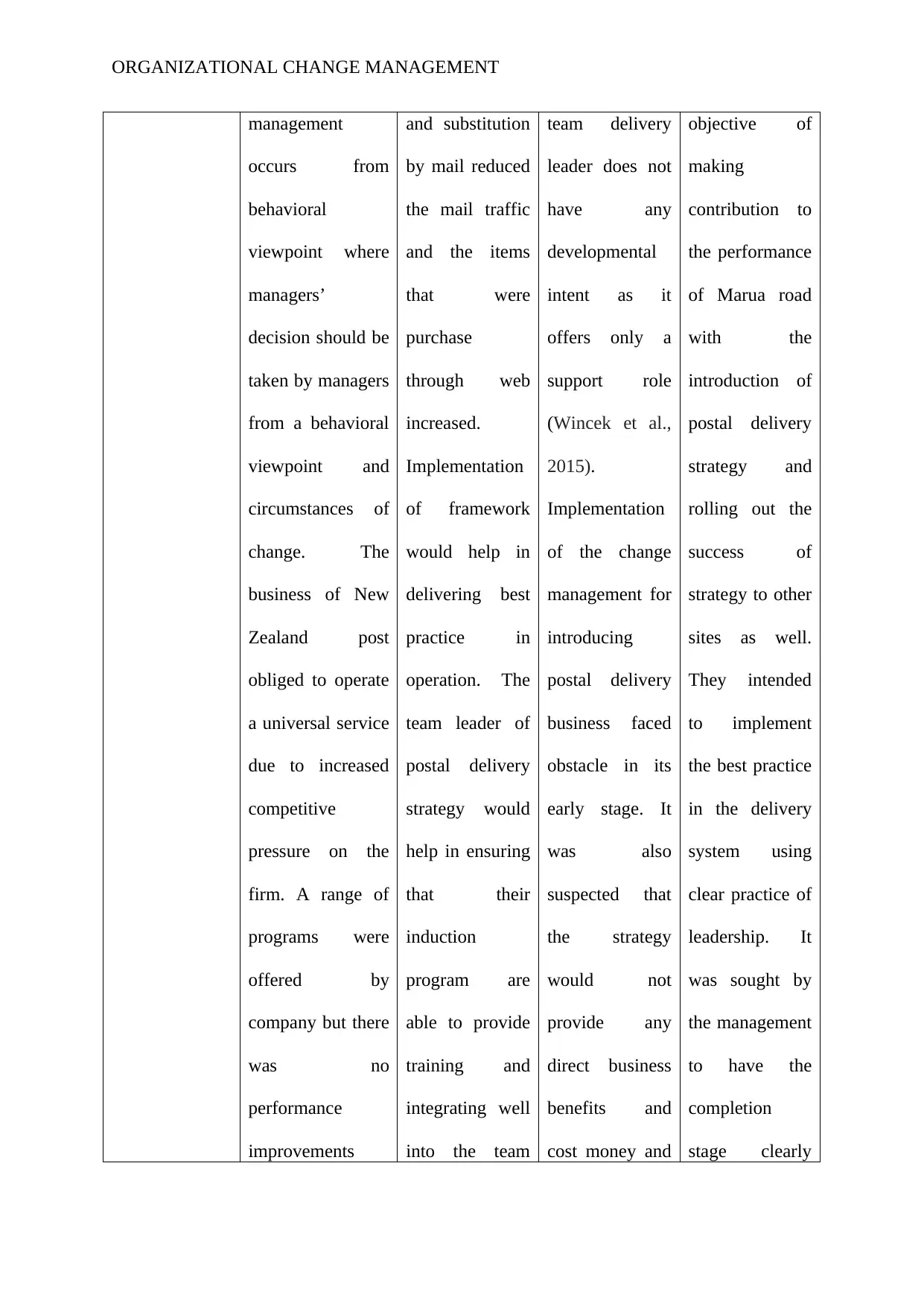
ORGANIZATIONAL CHANGE MANAGEMENT
management
occurs from
behavioral
viewpoint where
managers’
decision should be
taken by managers
from a behavioral
viewpoint and
circumstances of
change. The
business of New
Zealand post
obliged to operate
a universal service
due to increased
competitive
pressure on the
firm. A range of
programs were
offered by
company but there
was no
performance
improvements
and substitution
by mail reduced
the mail traffic
and the items
that were
purchase
through web
increased.
Implementation
of framework
would help in
delivering best
practice in
operation. The
team leader of
postal delivery
strategy would
help in ensuring
that their
induction
program are
able to provide
training and
integrating well
into the team
team delivery
leader does not
have any
developmental
intent as it
offers only a
support role
(Wincek et al.,
2015).
Implementation
of the change
management for
introducing
postal delivery
business faced
obstacle in its
early stage. It
was also
suspected that
the strategy
would not
provide any
direct business
benefits and
cost money and
objective of
making
contribution to
the performance
of Marua road
with the
introduction of
postal delivery
strategy and
rolling out the
success of
strategy to other
sites as well.
They intended
to implement
the best practice
in the delivery
system using
clear practice of
leadership. It
was sought by
the management
to have the
completion
stage clearly
management
occurs from
behavioral
viewpoint where
managers’
decision should be
taken by managers
from a behavioral
viewpoint and
circumstances of
change. The
business of New
Zealand post
obliged to operate
a universal service
due to increased
competitive
pressure on the
firm. A range of
programs were
offered by
company but there
was no
performance
improvements
and substitution
by mail reduced
the mail traffic
and the items
that were
purchase
through web
increased.
Implementation
of framework
would help in
delivering best
practice in
operation. The
team leader of
postal delivery
strategy would
help in ensuring
that their
induction
program are
able to provide
training and
integrating well
into the team
team delivery
leader does not
have any
developmental
intent as it
offers only a
support role
(Wincek et al.,
2015).
Implementation
of the change
management for
introducing
postal delivery
business faced
obstacle in its
early stage. It
was also
suspected that
the strategy
would not
provide any
direct business
benefits and
cost money and
objective of
making
contribution to
the performance
of Marua road
with the
introduction of
postal delivery
strategy and
rolling out the
success of
strategy to other
sites as well.
They intended
to implement
the best practice
in the delivery
system using
clear practice of
leadership. It
was sought by
the management
to have the
completion
stage clearly
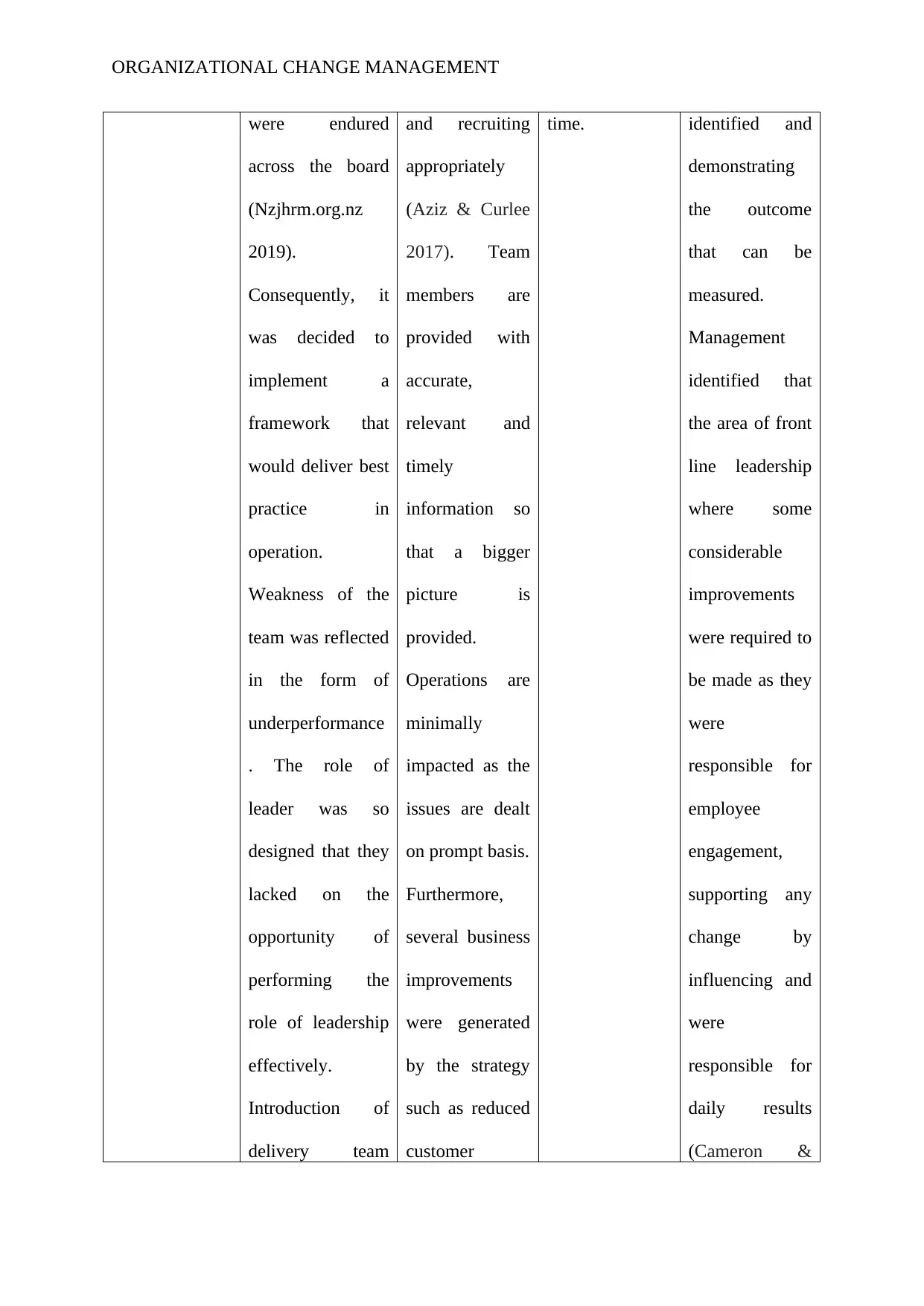
ORGANIZATIONAL CHANGE MANAGEMENT
were endured
across the board
(Nzjhrm.org.nz
2019).
Consequently, it
was decided to
implement a
framework that
would deliver best
practice in
operation.
Weakness of the
team was reflected
in the form of
underperformance
. The role of
leader was so
designed that they
lacked on the
opportunity of
performing the
role of leadership
effectively.
Introduction of
delivery team
and recruiting
appropriately
(Aziz & Curlee
2017). Team
members are
provided with
accurate,
relevant and
timely
information so
that a bigger
picture is
provided.
Operations are
minimally
impacted as the
issues are dealt
on prompt basis.
Furthermore,
several business
improvements
were generated
by the strategy
such as reduced
customer
time. identified and
demonstrating
the outcome
that can be
measured.
Management
identified that
the area of front
line leadership
where some
considerable
improvements
were required to
be made as they
were
responsible for
employee
engagement,
supporting any
change by
influencing and
were
responsible for
daily results
(Cameron &
were endured
across the board
(Nzjhrm.org.nz
2019).
Consequently, it
was decided to
implement a
framework that
would deliver best
practice in
operation.
Weakness of the
team was reflected
in the form of
underperformance
. The role of
leader was so
designed that they
lacked on the
opportunity of
performing the
role of leadership
effectively.
Introduction of
delivery team
and recruiting
appropriately
(Aziz & Curlee
2017). Team
members are
provided with
accurate,
relevant and
timely
information so
that a bigger
picture is
provided.
Operations are
minimally
impacted as the
issues are dealt
on prompt basis.
Furthermore,
several business
improvements
were generated
by the strategy
such as reduced
customer
time. identified and
demonstrating
the outcome
that can be
measured.
Management
identified that
the area of front
line leadership
where some
considerable
improvements
were required to
be made as they
were
responsible for
employee
engagement,
supporting any
change by
influencing and
were
responsible for
daily results
(Cameron &
⊘ This is a preview!⊘
Do you want full access?
Subscribe today to unlock all pages.

Trusted by 1+ million students worldwide
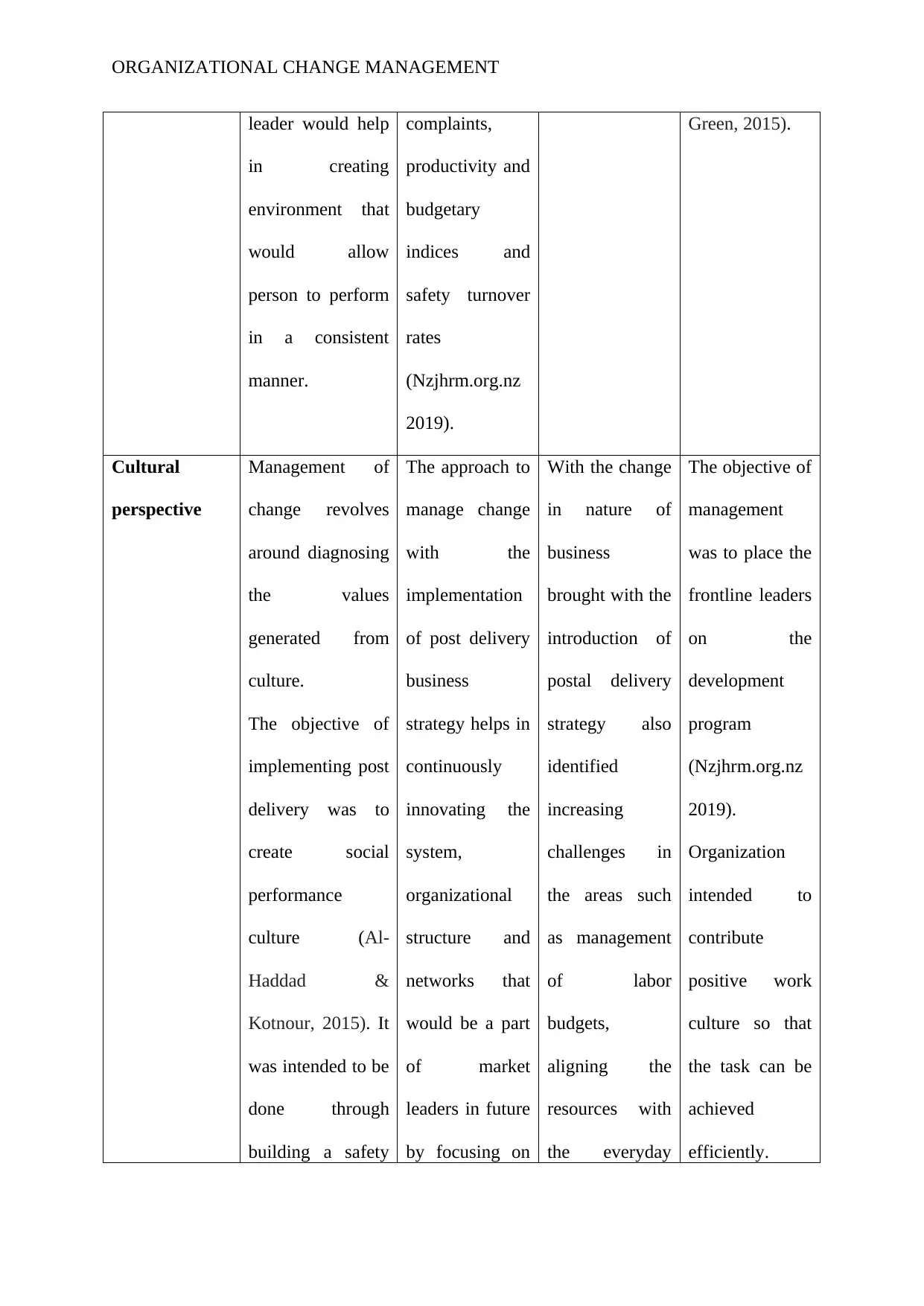
ORGANIZATIONAL CHANGE MANAGEMENT
leader would help
in creating
environment that
would allow
person to perform
in a consistent
manner.
complaints,
productivity and
budgetary
indices and
safety turnover
rates
(Nzjhrm.org.nz
2019).
Green, 2015).
Cultural
perspective
Management of
change revolves
around diagnosing
the values
generated from
culture.
The objective of
implementing post
delivery was to
create social
performance
culture (Al-
Haddad &
Kotnour, 2015). It
was intended to be
done through
building a safety
The approach to
manage change
with the
implementation
of post delivery
business
strategy helps in
continuously
innovating the
system,
organizational
structure and
networks that
would be a part
of market
leaders in future
by focusing on
With the change
in nature of
business
brought with the
introduction of
postal delivery
strategy also
identified
increasing
challenges in
the areas such
as management
of labor
budgets,
aligning the
resources with
the everyday
The objective of
management
was to place the
frontline leaders
on the
development
program
(Nzjhrm.org.nz
2019).
Organization
intended to
contribute
positive work
culture so that
the task can be
achieved
efficiently.
leader would help
in creating
environment that
would allow
person to perform
in a consistent
manner.
complaints,
productivity and
budgetary
indices and
safety turnover
rates
(Nzjhrm.org.nz
2019).
Green, 2015).
Cultural
perspective
Management of
change revolves
around diagnosing
the values
generated from
culture.
The objective of
implementing post
delivery was to
create social
performance
culture (Al-
Haddad &
Kotnour, 2015). It
was intended to be
done through
building a safety
The approach to
manage change
with the
implementation
of post delivery
business
strategy helps in
continuously
innovating the
system,
organizational
structure and
networks that
would be a part
of market
leaders in future
by focusing on
With the change
in nature of
business
brought with the
introduction of
postal delivery
strategy also
identified
increasing
challenges in
the areas such
as management
of labor
budgets,
aligning the
resources with
the everyday
The objective of
management
was to place the
frontline leaders
on the
development
program
(Nzjhrm.org.nz
2019).
Organization
intended to
contribute
positive work
culture so that
the task can be
achieved
efficiently.
Paraphrase This Document
Need a fresh take? Get an instant paraphrase of this document with our AI Paraphraser
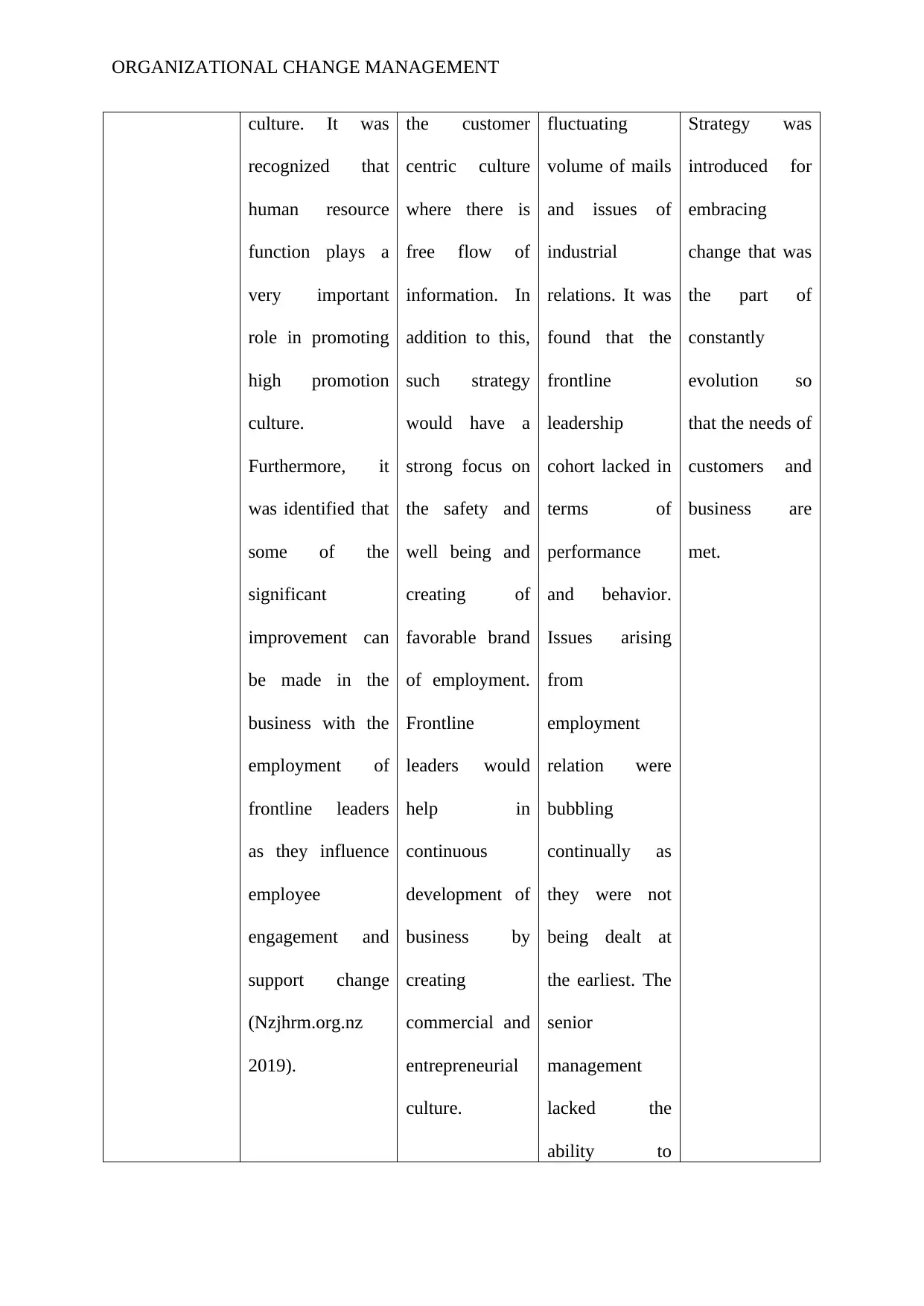
ORGANIZATIONAL CHANGE MANAGEMENT
culture. It was
recognized that
human resource
function plays a
very important
role in promoting
high promotion
culture.
Furthermore, it
was identified that
some of the
significant
improvement can
be made in the
business with the
employment of
frontline leaders
as they influence
employee
engagement and
support change
(Nzjhrm.org.nz
2019).
the customer
centric culture
where there is
free flow of
information. In
addition to this,
such strategy
would have a
strong focus on
the safety and
well being and
creating of
favorable brand
of employment.
Frontline
leaders would
help in
continuous
development of
business by
creating
commercial and
entrepreneurial
culture.
fluctuating
volume of mails
and issues of
industrial
relations. It was
found that the
frontline
leadership
cohort lacked in
terms of
performance
and behavior.
Issues arising
from
employment
relation were
bubbling
continually as
they were not
being dealt at
the earliest. The
senior
management
lacked the
ability to
Strategy was
introduced for
embracing
change that was
the part of
constantly
evolution so
that the needs of
customers and
business are
met.
culture. It was
recognized that
human resource
function plays a
very important
role in promoting
high promotion
culture.
Furthermore, it
was identified that
some of the
significant
improvement can
be made in the
business with the
employment of
frontline leaders
as they influence
employee
engagement and
support change
(Nzjhrm.org.nz
2019).
the customer
centric culture
where there is
free flow of
information. In
addition to this,
such strategy
would have a
strong focus on
the safety and
well being and
creating of
favorable brand
of employment.
Frontline
leaders would
help in
continuous
development of
business by
creating
commercial and
entrepreneurial
culture.
fluctuating
volume of mails
and issues of
industrial
relations. It was
found that the
frontline
leadership
cohort lacked in
terms of
performance
and behavior.
Issues arising
from
employment
relation were
bubbling
continually as
they were not
being dealt at
the earliest. The
senior
management
lacked the
ability to
Strategy was
introduced for
embracing
change that was
the part of
constantly
evolution so
that the needs of
customers and
business are
met.
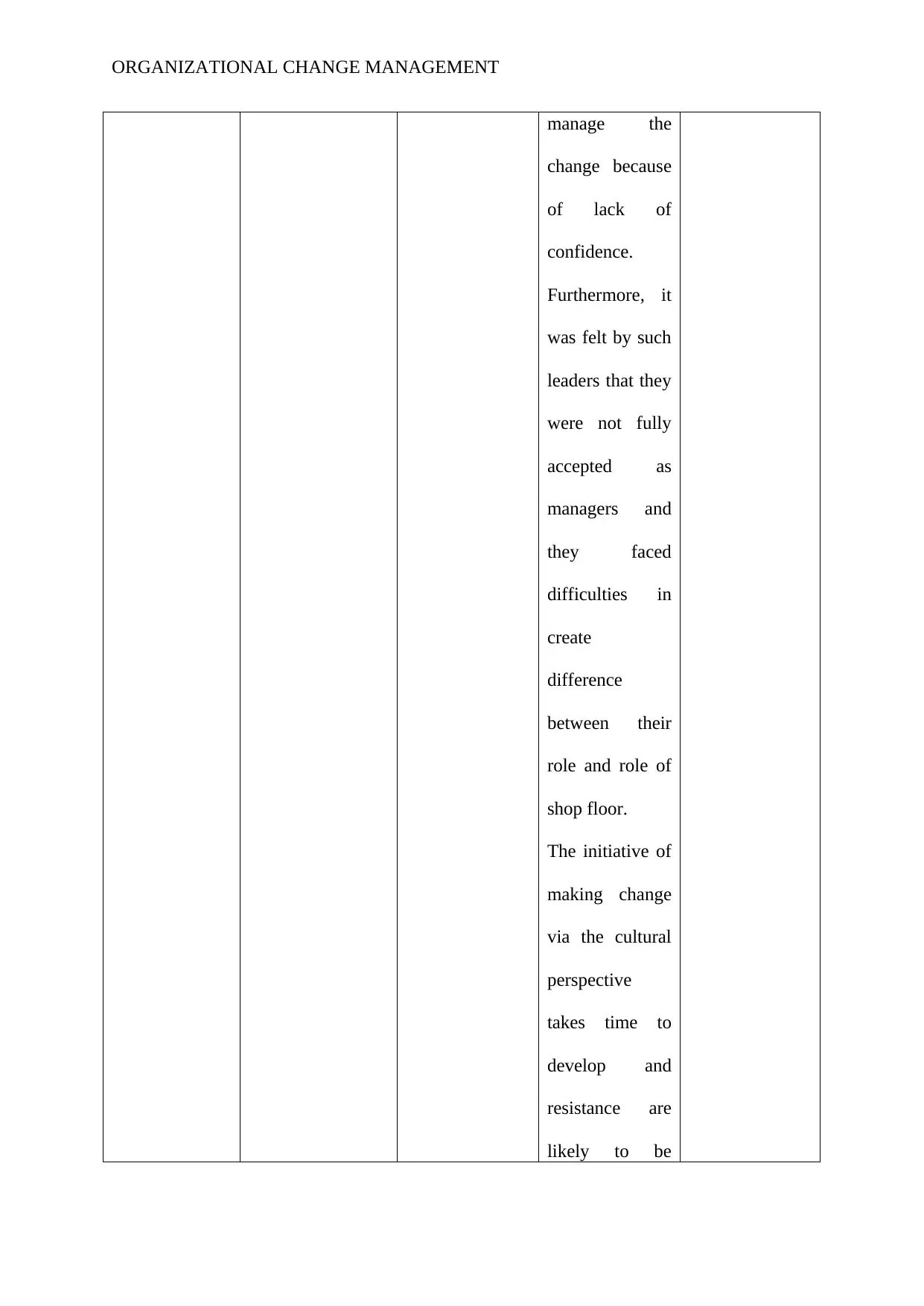
ORGANIZATIONAL CHANGE MANAGEMENT
manage the
change because
of lack of
confidence.
Furthermore, it
was felt by such
leaders that they
were not fully
accepted as
managers and
they faced
difficulties in
create
difference
between their
role and role of
shop floor.
The initiative of
making change
via the cultural
perspective
takes time to
develop and
resistance are
likely to be
manage the
change because
of lack of
confidence.
Furthermore, it
was felt by such
leaders that they
were not fully
accepted as
managers and
they faced
difficulties in
create
difference
between their
role and role of
shop floor.
The initiative of
making change
via the cultural
perspective
takes time to
develop and
resistance are
likely to be
⊘ This is a preview!⊘
Do you want full access?
Subscribe today to unlock all pages.

Trusted by 1+ million students worldwide
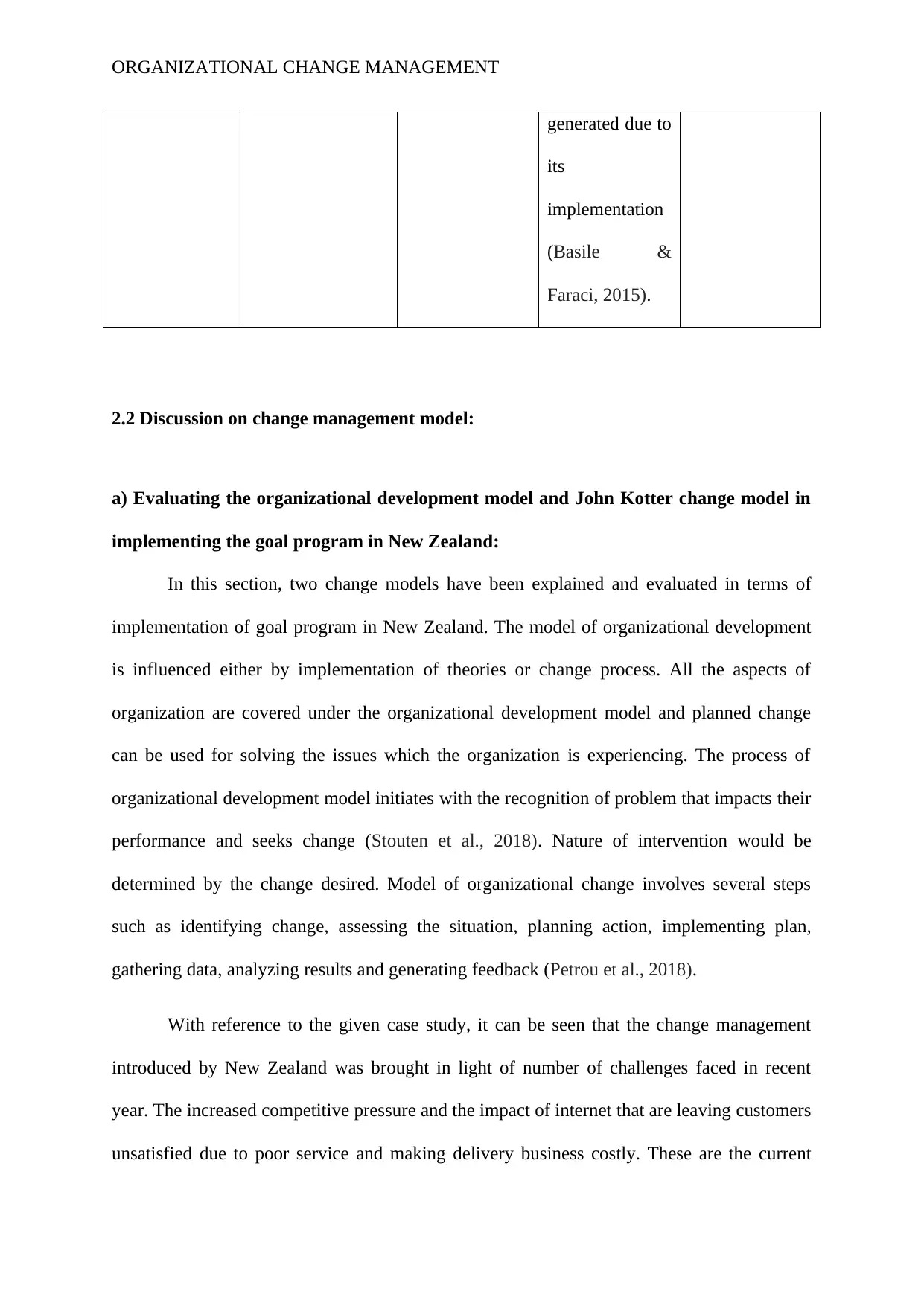
ORGANIZATIONAL CHANGE MANAGEMENT
generated due to
its
implementation
(Basile &
Faraci, 2015).
2.2 Discussion on change management model:
a) Evaluating the organizational development model and John Kotter change model in
implementing the goal program in New Zealand:
In this section, two change models have been explained and evaluated in terms of
implementation of goal program in New Zealand. The model of organizational development
is influenced either by implementation of theories or change process. All the aspects of
organization are covered under the organizational development model and planned change
can be used for solving the issues which the organization is experiencing. The process of
organizational development model initiates with the recognition of problem that impacts their
performance and seeks change (Stouten et al., 2018). Nature of intervention would be
determined by the change desired. Model of organizational change involves several steps
such as identifying change, assessing the situation, planning action, implementing plan,
gathering data, analyzing results and generating feedback (Petrou et al., 2018).
With reference to the given case study, it can be seen that the change management
introduced by New Zealand was brought in light of number of challenges faced in recent
year. The increased competitive pressure and the impact of internet that are leaving customers
unsatisfied due to poor service and making delivery business costly. These are the current
generated due to
its
implementation
(Basile &
Faraci, 2015).
2.2 Discussion on change management model:
a) Evaluating the organizational development model and John Kotter change model in
implementing the goal program in New Zealand:
In this section, two change models have been explained and evaluated in terms of
implementation of goal program in New Zealand. The model of organizational development
is influenced either by implementation of theories or change process. All the aspects of
organization are covered under the organizational development model and planned change
can be used for solving the issues which the organization is experiencing. The process of
organizational development model initiates with the recognition of problem that impacts their
performance and seeks change (Stouten et al., 2018). Nature of intervention would be
determined by the change desired. Model of organizational change involves several steps
such as identifying change, assessing the situation, planning action, implementing plan,
gathering data, analyzing results and generating feedback (Petrou et al., 2018).
With reference to the given case study, it can be seen that the change management
introduced by New Zealand was brought in light of number of challenges faced in recent
year. The increased competitive pressure and the impact of internet that are leaving customers
unsatisfied due to poor service and making delivery business costly. These are the current
Paraphrase This Document
Need a fresh take? Get an instant paraphrase of this document with our AI Paraphraser
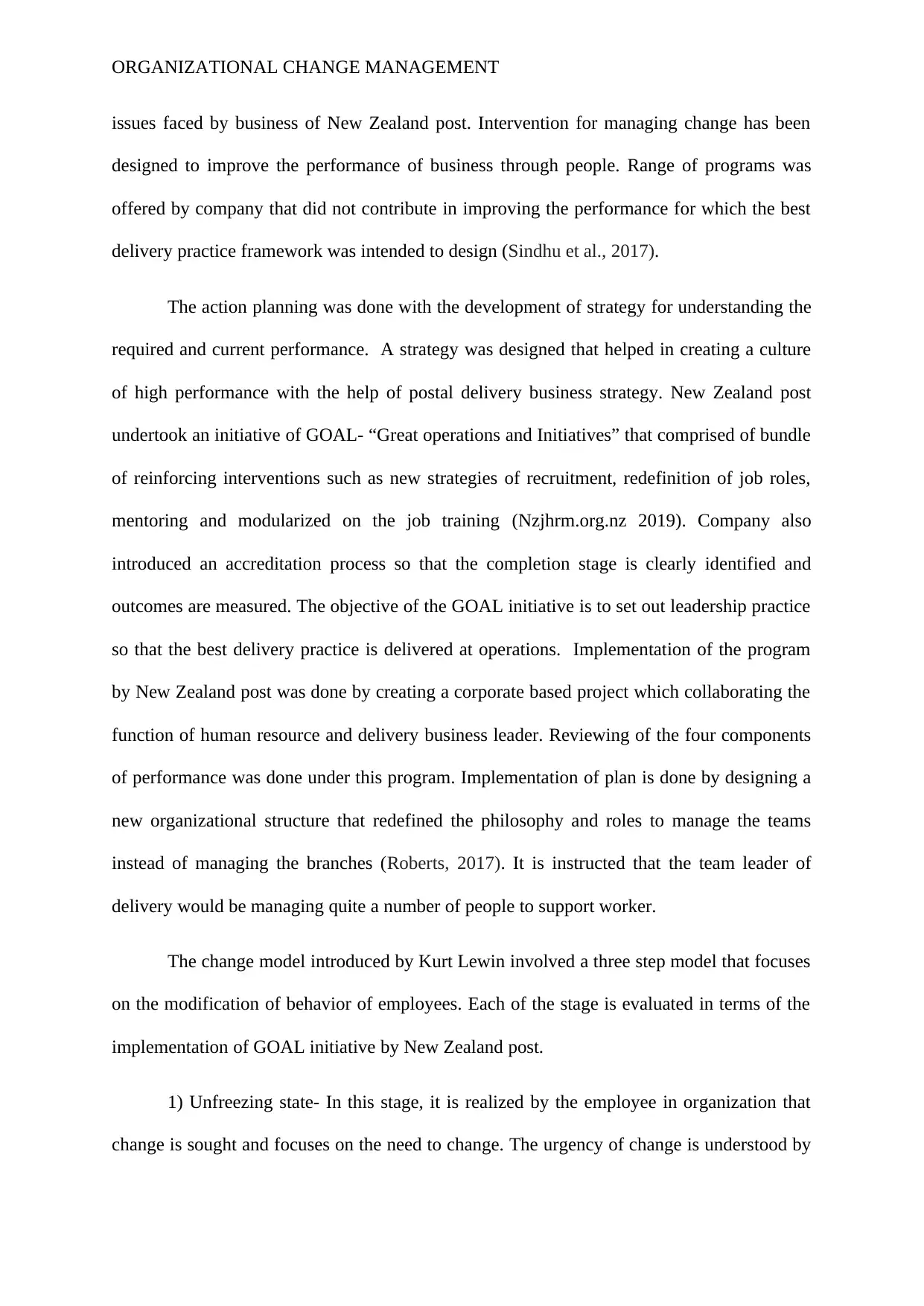
ORGANIZATIONAL CHANGE MANAGEMENT
issues faced by business of New Zealand post. Intervention for managing change has been
designed to improve the performance of business through people. Range of programs was
offered by company that did not contribute in improving the performance for which the best
delivery practice framework was intended to design (Sindhu et al., 2017).
The action planning was done with the development of strategy for understanding the
required and current performance. A strategy was designed that helped in creating a culture
of high performance with the help of postal delivery business strategy. New Zealand post
undertook an initiative of GOAL- “Great operations and Initiatives” that comprised of bundle
of reinforcing interventions such as new strategies of recruitment, redefinition of job roles,
mentoring and modularized on the job training (Nzjhrm.org.nz 2019). Company also
introduced an accreditation process so that the completion stage is clearly identified and
outcomes are measured. The objective of the GOAL initiative is to set out leadership practice
so that the best delivery practice is delivered at operations. Implementation of the program
by New Zealand post was done by creating a corporate based project which collaborating the
function of human resource and delivery business leader. Reviewing of the four components
of performance was done under this program. Implementation of plan is done by designing a
new organizational structure that redefined the philosophy and roles to manage the teams
instead of managing the branches (Roberts, 2017). It is instructed that the team leader of
delivery would be managing quite a number of people to support worker.
The change model introduced by Kurt Lewin involved a three step model that focuses
on the modification of behavior of employees. Each of the stage is evaluated in terms of the
implementation of GOAL initiative by New Zealand post.
1) Unfreezing state- In this stage, it is realized by the employee in organization that
change is sought and focuses on the need to change. The urgency of change is understood by
issues faced by business of New Zealand post. Intervention for managing change has been
designed to improve the performance of business through people. Range of programs was
offered by company that did not contribute in improving the performance for which the best
delivery practice framework was intended to design (Sindhu et al., 2017).
The action planning was done with the development of strategy for understanding the
required and current performance. A strategy was designed that helped in creating a culture
of high performance with the help of postal delivery business strategy. New Zealand post
undertook an initiative of GOAL- “Great operations and Initiatives” that comprised of bundle
of reinforcing interventions such as new strategies of recruitment, redefinition of job roles,
mentoring and modularized on the job training (Nzjhrm.org.nz 2019). Company also
introduced an accreditation process so that the completion stage is clearly identified and
outcomes are measured. The objective of the GOAL initiative is to set out leadership practice
so that the best delivery practice is delivered at operations. Implementation of the program
by New Zealand post was done by creating a corporate based project which collaborating the
function of human resource and delivery business leader. Reviewing of the four components
of performance was done under this program. Implementation of plan is done by designing a
new organizational structure that redefined the philosophy and roles to manage the teams
instead of managing the branches (Roberts, 2017). It is instructed that the team leader of
delivery would be managing quite a number of people to support worker.
The change model introduced by Kurt Lewin involved a three step model that focuses
on the modification of behavior of employees. Each of the stage is evaluated in terms of the
implementation of GOAL initiative by New Zealand post.
1) Unfreezing state- In this stage, it is realized by the employee in organization that
change is sought and focuses on the need to change. The urgency of change is understood by
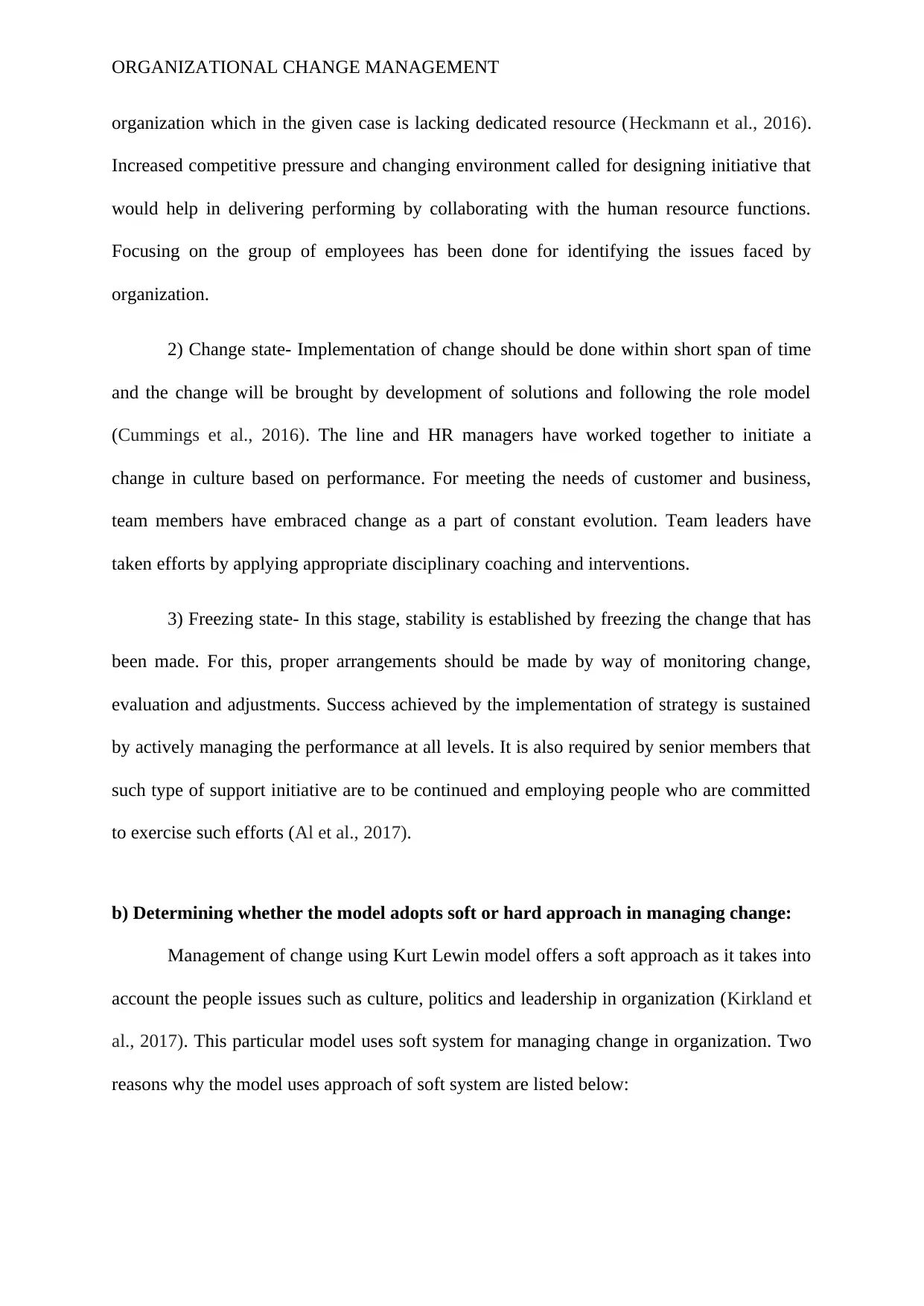
ORGANIZATIONAL CHANGE MANAGEMENT
organization which in the given case is lacking dedicated resource (Heckmann et al., 2016).
Increased competitive pressure and changing environment called for designing initiative that
would help in delivering performing by collaborating with the human resource functions.
Focusing on the group of employees has been done for identifying the issues faced by
organization.
2) Change state- Implementation of change should be done within short span of time
and the change will be brought by development of solutions and following the role model
(Cummings et al., 2016). The line and HR managers have worked together to initiate a
change in culture based on performance. For meeting the needs of customer and business,
team members have embraced change as a part of constant evolution. Team leaders have
taken efforts by applying appropriate disciplinary coaching and interventions.
3) Freezing state- In this stage, stability is established by freezing the change that has
been made. For this, proper arrangements should be made by way of monitoring change,
evaluation and adjustments. Success achieved by the implementation of strategy is sustained
by actively managing the performance at all levels. It is also required by senior members that
such type of support initiative are to be continued and employing people who are committed
to exercise such efforts (Al et al., 2017).
b) Determining whether the model adopts soft or hard approach in managing change:
Management of change using Kurt Lewin model offers a soft approach as it takes into
account the people issues such as culture, politics and leadership in organization (Kirkland et
al., 2017). This particular model uses soft system for managing change in organization. Two
reasons why the model uses approach of soft system are listed below:
organization which in the given case is lacking dedicated resource (Heckmann et al., 2016).
Increased competitive pressure and changing environment called for designing initiative that
would help in delivering performing by collaborating with the human resource functions.
Focusing on the group of employees has been done for identifying the issues faced by
organization.
2) Change state- Implementation of change should be done within short span of time
and the change will be brought by development of solutions and following the role model
(Cummings et al., 2016). The line and HR managers have worked together to initiate a
change in culture based on performance. For meeting the needs of customer and business,
team members have embraced change as a part of constant evolution. Team leaders have
taken efforts by applying appropriate disciplinary coaching and interventions.
3) Freezing state- In this stage, stability is established by freezing the change that has
been made. For this, proper arrangements should be made by way of monitoring change,
evaluation and adjustments. Success achieved by the implementation of strategy is sustained
by actively managing the performance at all levels. It is also required by senior members that
such type of support initiative are to be continued and employing people who are committed
to exercise such efforts (Al et al., 2017).
b) Determining whether the model adopts soft or hard approach in managing change:
Management of change using Kurt Lewin model offers a soft approach as it takes into
account the people issues such as culture, politics and leadership in organization (Kirkland et
al., 2017). This particular model uses soft system for managing change in organization. Two
reasons why the model uses approach of soft system are listed below:
⊘ This is a preview!⊘
Do you want full access?
Subscribe today to unlock all pages.

Trusted by 1+ million students worldwide
1 out of 16
Related Documents
Your All-in-One AI-Powered Toolkit for Academic Success.
+13062052269
info@desklib.com
Available 24*7 on WhatsApp / Email
![[object Object]](/_next/static/media/star-bottom.7253800d.svg)
Unlock your academic potential
Copyright © 2020–2025 A2Z Services. All Rights Reserved. Developed and managed by ZUCOL.




